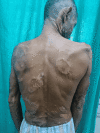Leprosy in Post-elimination Era: A Study Conducted in Rural Tertiary Settings in North India
- PMID: 38826938
- PMCID: PMC11141888
- DOI: 10.7759/cureus.59464
Leprosy in Post-elimination Era: A Study Conducted in Rural Tertiary Settings in North India
Abstract
Background Leprosy is an age-old disease caused by Mycobacterium leprae. The disease was declared eradicated in India in 2005. Many new cases are still being identified in the outdoor patient department. This study was undertaken to understand the epidemiological, clinical, and social aspects of leprosy among new patients, and assess the current situation regarding caseload and presentation. Material and methods This study was designed as an observational study. It was carried out in people newly diagnosed with leprosy attending the outpatient department of Dermatology, Venereology, and Leprology in the tertiary care hospital in Uttar Pradesh University of Medical Sciences from July 2022 to January 2024. A total of 231 people afflicted with leprosy were included in the study. The data collected was statistically analyzed to identify demographic and social patterns, clinical presentations, and features associated with leprosy. Result Out of these 231 patients, 139 (60.17%) were male and 92 (39.83%) were female. Most cases belonged to the age group 40-59 years 87 (37.66%). History of close contact with an afflicted person was present in 34 (14.71%). Clinically, most patients belong to the borderline tuberculoid (BT) type. Only 24 (10.4%) patients were found positive for M. leprae by slit-skin smear examination. The ulnar nerve was the most common nerve involved in 63 (27.27%) cases. Trophic ulcers were the predominant deformity in 34 (14.7%), followed by foot drop in 13 (5.62 %). Conclusion The present study provides an overview of the prevailing trends of Leprosy within a specific region in the post-elimination era. The findings underscore the significance of the ongoing National Leprosy Eradication Program (NLEP) program and stress the importance of aligning them with the common goal of eliminating the burden and stigma of Leprosy from society.
Keywords: deformity; lepra reactions; leprosy; nerves; nlep; stigma.
Copyright © 2024, Kumar et al.
Conflict of interest statement
The authors have declared that no competing interests exist.
Figures





References
-
- Leprosy: clinical aspects and diagnostic techniques. Maymone MB, Laughter M, Venkatesh S, et al. J Am Acad Dermatol. 2020;83:1–14. - PubMed
-
- Classification of leprosy according to immunity. A five-group system. Ridley DS, Jopling WH. https://pubmed.ncbi.nlm.nih.gov/5950347/ Int J Lepr Other Mycobact Dis. 1966;34:255–273. - PubMed
-
- Leprosy. [ Feb; 2024 ]. 2024. https://www.who.int/news-room/fact-sheets/detail/leprosy https://www.who.int/news-room/fact-sheets/detail/leprosy
LinkOut - more resources
Full Text Sources
